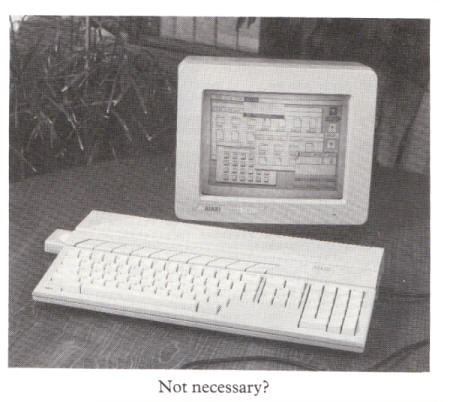 Whilst browsing
around the 1987 PCW Show, looking at the latest batch of ST
software, a startling thought entered my mind 'Do I need a 16-bit
computer?'. This thought preyed on my mind, almost converting a
dedicated 8-bit fan to the way of the ST! After a great deal of
deliberation I made my decision, to be revealed later, but for now
I'll go over the factors that were given due consideration.
Whilst browsing
around the 1987 PCW Show, looking at the latest batch of ST
software, a startling thought entered my mind 'Do I need a 16-bit
computer?'. This thought preyed on my mind, almost converting a
dedicated 8-bit fan to the way of the ST! After a great deal of
deliberation I made my decision, to be revealed later, but for now
I'll go over the factors that were given due consideration.
Price of a set-up was an initial factor. This works out about equal,
though bargain hunters could make the 130XE and a 1050 disk drive a
winner hands down. The cost of a 520 STFM constantly being brought
down as dealers fight for trade, and the XE price increase by Atari,
made this a very marginal argument. It could also prove the point
that Atari want to give the 8-bit side less commitment and the ST's
more support.
The 'Power without the Price' slogan brings us to the speed and
power concept. There have been a lot of myths about the ST's
operational speed, so lets have some facts. Theoretically, the ST
should execute programs between 5 and 20 times faster than an 8-bit,
dependant on the application being run. Without getting too
technical, speed depends on the language being used and how well
that language is implemented. As an example ST LOGO runs at
approximately the same speed as 8-bit LOGO! Given that most people
are BASIC programmers, lets clear the air in that department. With
the exceptions of complex calculations and considerable disk
Input/Output operations, ST Basic is no more than 25% faster than
public domain Turbo-Basic or OSS's Basic XL/XE.
BETTER GRAPHICS?
How about the theories that the ST's can run larger programs? True,
but can you imagine the limitations of a 1 meg XE? It could be done.
Then there is the one about the ST's capability to display better
graphics. False. Everyone thought that the demo's that were
displayed on the ST's public debut, were, to say the least,
fantastic. These demo's encouraged some 6502 programmers to show the
Atari community that the 8-bit computers can produce graphic
displays that match the quality of the ST's. Evidence of this is
found on PAGE 6 Library Disk #42 — Special Demos, which contains
exact replicas of the ST demo's — one is even an improved version!
Also on the graphics topic, we can't forget the fanatics who are
looking for the `ultimate' games machine. To them, I have only one
thing to say: I have yet to see an ST game that can satisfy me as
much as level 63 on Rescue on Fractalus! Sound played a minor role
in my decision. The ST's supposedly 'lousy' sound chip does match
POKEY, and having heard digitised music on both machines I decided
to ignore this factor!
These points don't mean that everyone should rush out and purchase
an 8-bit system. I am simply doubting whether people can benefit
from the, as yet, unrealised capabilities of the ST. And even when
that full potential becomes reality, how many users will need more
power than can be obtained from an XE? Business, scientific,
technical users, etc., will need the extra speed and power, but can
you justify the extra expense if all you do is write a couple of
letters each month and keep track of your personal finances. With
512/1024K are you writing a letter or your biography?
HOW EASY TO PROGRAM?
Down to the nitty-gritty from the would be programmers point of
view. How easy is to program the computers? Atari BASIC is
straightforward, switch on and its there, but with ST BASIC you have
to learn (or should that be master?) the GEM environment, to load
and use BASIC to the full. Do you need multiple pop down menus to
write a program? What about actually writing programs? Without
graphics, programs can be written with relative ease on both
machines. With simple graphics, it's the same case, a snip on both
computers. Moving sprites? The beginner would find it slightly
difficult on the 8-bit, but then again, it's nearly impossible on
the ST. Somehow the XL/XE won this round.
WHAT PRICE SOFTWARE?
Software was a hard battle. Do I fork out in excess of £25 for an ST
title from my local W.H. Smiths or do I gamble a £10 cheque with the
Post Office, for a mail order 8-bit title because W.H. Smiths don't
think it would sell if they did stock it. Thought was also given to
the price I would have to pay for a blank disk and disk boxes, but
with 'disk wars' continuing between the big distributors, I am
keeping an open mind on this item.
THE FINAL DECISION
Anyway my final decision? To stick with my
faithful 800 XL. For now an 8-bit system is more than adequate. I
may change in years to come when the ST is more firmly established
and the majority of the 'fast buck' dealers have gone, but at this
moment in time, I for one do not need in excess of 512K to write a
letter or keep track of my cheque book. An interesting foot-note is
whether I have touched an open nerve in the ST camp? Will they sit
back and sulk, knowing I'm right, or will they write in trying to
add more controversy? We shall have to wait and see.